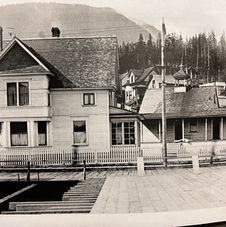St. Elizabeth's & St. John's
Ministry of Reconciliation
Credits to Sis Coenen, Church Historian, and David Kiffer

Heading 6
The Diocese of Alaska
The Missionary District of Alaska was established in 1895 and became a diocese in 1970. Today the Diocese supports about 50 parishes and missions throughout Alaska. The Bishop's offices are located in Fairbanks.
St. John's Church
When St. John's began, the town was only a village, the waterfront only a beach and its mission only a dream. In 1897, a white trader approached Bishop Rowe and offered two acres of his squatter's claim in return for a pledge that the Church would start a school for the Native children. The Episcopal Church in Ketchikan had its beginning.
Dr. Campbell, a physician and priest, began visiting the Mission when he could from his church in Douglas, Alaska.
St. John's is the first church built in Ketchikan and remains today in its original location.
School & St. Agnes Mission
Miss Agnes Edmond, a missionary and teacher, was called to Ketchikan from the East Coast to begin the work of the Mission. She is thought to be the first white female to permanently reside in Ketchikan. Known for her revival of basketry, she helped support the Mission by selling Native art work to tourists. In the absence of a priest, she held Sunday school and an evening song service. The school was considered one of the best in the Territory. St. Agnes Mission was located at the end of what came to be Edmond Street.
After operating for nearly 25 years, the school was turned over to the Office of Indian Affairs.
The New Church, St. John's
Tsimshian Elder Gertrude Johnson said, "The native people gave him [Bp. Rowe] a piece of land right in the center of town where St. John's now stands. That was Indian land! ....The Native people did the carpentry work and all the beautiful wood carvings on the ceiling and the altar."
Able Tlingit and Nisga'a craftsmen and white settlers began construction of the church building in 1903. Tongue and groove red cedar cut at the Verney brother's sawmill in North Saxman framed the interior. Old annals say nearly 100 people filed in for the mission service in Ketchikan so when St. John's opened its doors, it was full. St. John's remains as beautiful now as it did it in 1904.
Little Flower Hospital
The Church invited the Sisters of St. Joseph of Peace in 1909 to operate the first hospital directly across from the Church on Mission Street. Stories of the six plucky, indomitable ladies are available at the Tongass Historical Museum.
St. Elizabeth's
By 1927, the white population had increased considerably and desire grew for Alaska's First People to have a church of their own. Bishop Rowe spearheaded the drive for a new building on Deermount Avenue.
St. Elizabeth's flourished until 1962 with a long line of clergy and active lay ministers. Regrettably, the Church was shuttered by the Bishop citing costs of maintaining two Episcopal churches. Memories of the Church remain difficult for some families. Healing takes time.
The Canadian Connection
In 1857, the Church of England sent Father William Duncan to minister to the Tsimshian people in Fort Simpson, British Columbia. About 20 years later Father Duncan moved with many of his parishioners to (New) Metlakatla on Annette Island near Ketchikan. There he established a thriving community rich in culture still today.
However, at the time, year-round employment in Ketchikan spurred many of those families to move to Ketchikan for steady jobs. Several of them joined St. John's.
Arthur Yates Memorial Hospital
In 1906 the clergy house was built next to the Church. With the opening of the mines and sawmills in the area, needs for care of the sick and wounded grew. The clergy house was converted to a 12-bed hospital in honor of Dr. Arthur Yates. In 1925 a larger hospital was built around the corner on Bawden Street (now demolished).
The Yates building then became home to several entities: a mortuary, the Alaska Sportsman Magazine, the Seaman's Center, the Chamber of Commerce and now Historic Ketchikan. The Church hopes this lovely example of Colonial architecture can be preserved.
In the spirit of truth, unity and concord,
St. John's and St. Elizabeth's joined in a ceremony of Reconciliation in 2006. The design (above), titled "Together", commemorates healing. It is the work of Metlakatla artist Wilma Bainie who was commissioned for the occasion.
According to a parishioner from the old St. Elizabeth's congregation, "...This was the end of an era for a congregation overpowered by the dictates of those who did not understand them." St. John's continues to welcome everyone and prioritizes its downtown presence.
Several pieces were brought over from St. Elizabeth's: the large oil painting of Elizabeth and Mary (now in the sanctuary), the yellow cedar Altar with its communion vessels, vestments and elegant linens, music, the pews, lovely silver service and Baptismal Font. St. Elizabeth's Bishop's Chair now resides in Petersburg's Episcopal Church.

























